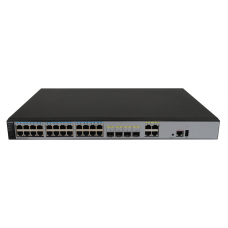| 02350KGF | AD9430DN-24 | AD9430DN-24 Mainframe(4 GE Combo Port,24 GE Port) |
AD9430DN Product Description
Product appearance
Appearance
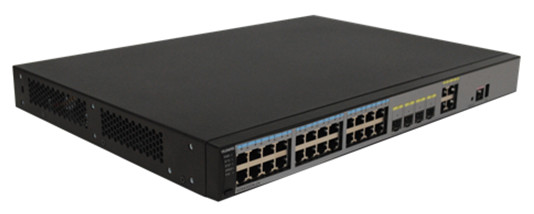
Interfaces
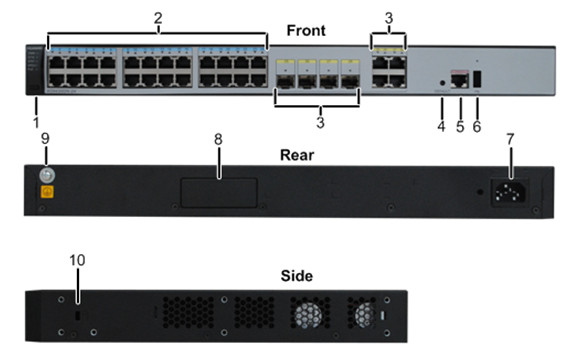
1. MODE button: Switches working mode of the indicator
2. Ethernet GE electrical interfaces: The AD9430DN-24 provides twenty-four 10M/100M/1,000M auto-sensing Ethernet electrical interfaces, and these interfaces support PoE power supply
3. Combo interface: Consists of an optical interface and an electrical interface. The two interfaces cannot work at the same time. The electrical interfaces support 10M/100M/1,000M auto-sensing, and the optical interfaces support eSFP optical modules
4. Default: A reset button used to restore factory settings if you hold down the button more than 3 seconds
5. Console interface: Connects to a maintenance terminal for device configuration and management
6. USB interface: Connects to a USB flash drive to transfer configuration and upgrade files
7. Power input interface for AC power supply
8. Filler panel reserved for network expansion
9. Ground point: Connects to the ground cable
10. Lock slot: Protects the device against theft
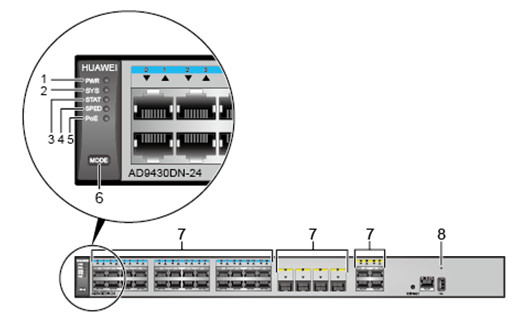
Table 1 describes indicators on the AD9430DN-24 front panel.
Description of indicators on the AD9430DN-24 front panel
| No. | Indicator/Button | Color | Description |
|---|---|---|---|
| 1 | Power Supply Indicator: PWR | Green |
Off: The device is powered off |
| 2 | System Status Indicator: SYS | - | Off: The system is not running. |
| Green |
Fast blinking: The system is starting |
||
| Yellow | Blinking: The device has entered the dormancy mode | ||
| Red | Steady on: After registering, the system does not operate properly, or a fan or temperature alarm has been generated | ||
| 3 | Status Mode Indicator: STAT | Green |
Steady on: The service port indicators are in the status mode (default) |
| 4 | Speed Mode Indicator: SPED | Green |
Steady on: The service port indicators show the port speed. After 45 seconds, the service port indicators automatically restore to the status mode |
| 5 | PoE Mode Indicator: PoE | Green |
Steady on: The service port indicators show the PoE status. After 45 seconds, the service port indicators automatically restore to the status mode Off: The PoE mode is not selected |
| 6 | Mode Switching Button: MODE | - |
When you press this button once, the service port indicators change to speed mode and show the speed of service ports |
| 7 |
Service Port Indicator |
Meanings of service port indicators vary in different modes. For details, see Table 2 | |
| 8 | USB Indicator | - |
Off (the possible causes are as follows): |
| Green |
Steady on: A USB-based deployment has been completed |
||
| Yellow | Steady on: The device has copied all the required files and completed the file check. The USB flash drive can be removed from the device | ||
| Red | Blinking: An error has occurred when the system is executing the configuration file or reading data from the USB flash drive | ||
Description of service interface indicators in different modes
| Display Mode | Color | Description |
|---|---|---|
| Status | Green |
Off: The port is not connected or has been shut down |
| Speed | Green |
Off: The port is not connected or has been shut down |
| PoE | Green |
Off: The port does not provide PoE power |
Product characteristics
WLAN features
- Compatibility with IEEE 802.11a/b/g/n/ac
- Maximum Ratio Combining (MRC)
- Cyclic Shift Diversity (CSD)
- Maximum Likelihood Detection (MLD)
- Data unit aggregation, including A-MPDU (Tx/Rx) and A-MSDU (Rx only)
- 802.11 Dynamic Frequency Selection (DFS)
- Short Guard Interval (GI) in 20 MHz, 40 MHz, and 80 MHz modes
- Priority mapping and packet scheduling according to a Wi-Fi Multimedia (WMM) profile for priority-based data processing and forwarding
- Automatic and manual rate adjustment (the rate is adjusted automatically by default)
- WLAN channel management and channel rate adjustment
- Automatic channel scanning and interference avoidance
- Service Set Identifier (SSID) hiding, support for SSIDs in Chinese
- Automatic SSID hiding: An AP automatically hides its SSIDs when the number of access terminals reaches the maximum
- Signal Sustain Technology (SST)
- Unscheduled Automatic Power Save Delivery (U-APSD)
- Control and Provisioning of Wireless Access Points (CAPWAP)
- Automatic access
- Hotspot 2.0
- 802.11k and 802.11v smart roaming
Network features
- IEEE 802.3u standards compliance
- Auto-negotiation of the rate and duplex mode; automatic switchover between the Media Dependent Interface (MDI) and Media Dependent Interface Crossover (MDI-X)
- SSID-based VLAN assignment
- 4,094 VLAN IDs (1 to 4,094)
- AP control channel in tagged and untagged mixed mode
- DHCP client (IP addresses are obtained through DHCP)
- Tunnel forwarding and direct forwarding
- STA isolation in the same VLAN
- Multicast Domain Name Service (mDNS) gateway protocol: supports AirPlay and AirPrint service sharing between users of different VLANs
- Access Control Lists (ACLs)
- Link Layer Discovery Protocol (LLDP)
- Service holding upon CAPWAP link disconnection in direct forwarding
- Unified authentication on the AC
- Soft GRE
QoS features
- Priority mapping and packet scheduling based on a WMM profile for priority-based data processing and forwarding
- WMM parameter management by radio
- WMM power saving
- Priority mapping for upstream packets and flow-based mapping for downstream packets
- Queue mapping and scheduling
- User-based bandwidth limit
- Adaptive bandwidth management (the system dynamically adjusts bandwidth allocation based on user quantity and environment to improve user experience)
Security features
- Open system authentication
- WEP authentication/encryption
- WPA/WPA2-PSK authentication and encryption
- WPA/WPA2-802.1x authentication and encryption
- WAPI authentication and encryption
- Wireless Intrusion Detection System (WIDS), including rogue AP and STA detection, attack detection, and STA/AP blacklist and whitelist
- 802.11w Protected Management Frames (PMFs)
Maintenance features
- Unified management and maintenance on the AC
- Plug-and-Play (PnP) in Fit AP mode: automatic access and configuration loading
- Automatic batch upgrades
- Local AP management using Telnet
- Real-time configuration monitoring and rapid fault location using the Network Management System (NMS)
- System status alarm
BYOD
- Identifies the device type according to the Organizationally Unique Identifier (OUI) in the MAC address
- Identifies the device type according to the User Agent (UA) information in an HTTP packet
- Identifies the device type according to DHCP options
- Allows the RADIUS server to deliver packet forwarding, security, and QoS policies according to the device type carried in the RADIUS authentication and accounting packets
Spectrum analysis
- Identifies interference sources such as Bluetooth devices, microwave ovens, cordless phones, ZigBee devices, wireless game controllers, 2.4 GHz/5 GHz wireless video and audio devices, and baby monitors
- Works with the Huawei eSight system to locate and perform spectrum analysis on interference sources
Product specifications
| Item | Description | |
|---|---|---|
| Physical Specifications | Dimensions (H x W x D) | 43.6 mm x 442 mm x 312 mm |
| System memory | 1 GB | |
| Power Specifications | Power input | Input voltage: 100V AC to 240V AC; 50 Hz/60 Hz |
| Environmental Specifications | Operating temperature | 0°C to 45°C |
| Storage temperature | –40°C to 70°C | |
| Operating humidity | 5% to 95% (non-condensing) | |
| Altitude | –60m to 5,000m | |
| Operating atmospheric pressure | 70 kPa to 106 kPa | |
| Performance Specifications | Forwarding capability | 4 Gbit/s |
| Interface type | Four uplink GE combo interfaces and 24 downlink GE interfaces | |
| Maximum number of managed RUs |
Without a switch: 24 With a switch: 48 |
|
| Number of users |
Maximum number of associated users: 4,096 Maximum number of concurrent users: 1,024 |
|
Networking and applications
On the network shown in the figure, RUs provide high-power radio signals and can be mounted on a ceiling or wall, or embedded into an 86-type box. A central AP connects to the RUs through network cables and provides PoE power for them. In addition, the central AP manages the RUs and processes services. It can be deployed in the ELV room and connects to more RUs through a PoE switch.
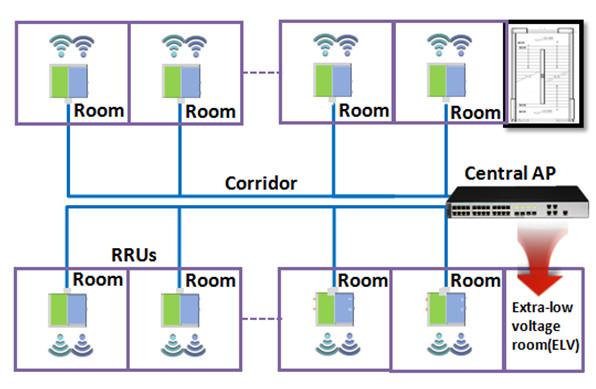
AD9430DN-24
- Brands Huawei
- Product Code: AD9430DN-24
- Availability: In Stock
-
$1,898.00
- Ex Tax: $1,898.00
Related Products
R240D
50083139 R240D-USA R240D Mainframe(11ac,2x2 Double Frequency,Built-in Antenna,United States ..
$222.00 Ex Tax: $222.00
Tags: ad9430dn-24, huawei, wlan






